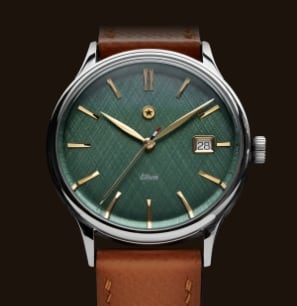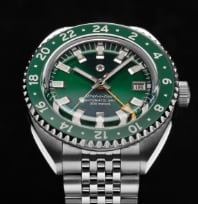Some of the newest timepieces to hit the market, solar watches are marvels of modern watchmakers. They combine the best parts of earlier types of watches while still maintaining the classic look of a traditional wristwatch, all while being a modern and eco-friendly alternative to other contemporary watch movements.
If you’re new to the world of solar timepieces and are hesitant to adopt this fascinating new technology, fear not—we’re here to explain how these cutting-edge timepieces work.
The Different Watch Movements
In order to understand why the solar watch is such a revolutionary invention in the world of watchmaking, we must first explore the other types of watch movement. A watch’s movement is, for lack of a better phrase, the thing that makes it tick. Some movements use batteries, and others use hand-wound mechanical components, but they all fulfill the same purpose: telling time. These are the various types of movement that watches are made with:
Mechanical
Mechanical watches, as the name suggests, are fully mechanical. They’ve been around for centuries—long before lithium batteries were invented—and derive power from a tiny, tightly coiled strip of metal called the mainspring.
The mainspring is wound by the watch’s wearer by twisting the crown of the watch (the crown is the knob on the side of the watch), and the other components of the watch work together to gradually release tension from the mainspring in small, measured increments that ultimately make the dial move.
The mechanical watch is truly a marvel of mechanical engineering, but it does come with one problem: it needs to be wound. If you put your mechanical watch down for a few days, you’ll pick it up to find that it’s slowed and the time is inaccurate—or that it has stopped running altogether. It can be time-consuming and inconvenient to constantly have to wind your watch, especially if you’re a collector with multiple mechanical watches or even a watch bracelet in your collection.
Automatic
The automatic watch was invented to solve the problem of mechanical watches. Instead of needing its wearer to manually wind its mainspring, an automatic watch winds itself—sort of.
An automatic watch is built with a special weighted rotor that rotates as the watch moves. When the watch’s wearer swings their arms as they walk, this weighted rotor spins around, gradually winding the watch’s mainspring.
While the automatic watch is certainly more convenient than the mechanical watch due to its self-winding capabilities, it comes with a similar problem: you have to be wearing it in order for it to wind itself. If you set it down anywhere from for a few days to a long period of time, just like with a mechanical watch, it will slowly lose power and eventually stop working.
You can always wind the watch and set the time again, and you can also get a special automatic watch winder, but if you’re looking for a watch that doesn’t need to be wound at all, you’ll need another option.
Quartz
The quartz watch is a 20th-century invention made possible through the use of a lithium battery. These tiny batteries replace the mainspring, making it possible to engineer a watch to tell accurate time for a long period without needing the watch’s wearer to do the work of winding it.
Many watches these days are built with quartz movements because of the ease of production and use—because they don’t use a mainspring, they can be made more compact and with fewer moving parts than their mechanical and automatic counterparts.
The one problem with these lithium batteries is that they need to be replaced regularly in order for the watch to maintain accurate time. As soon as they start to run out of power, the watch will start to lose accuracy, until eventually it no longer is useful as a timepiece.
Lithium batteries are not to be confused with lithium-ion batteries, which are more complex and powerful. They are used to power computers, cameras, and tablets.
Solar
Enter the solar watch onto the watch scene in the 70s. The newest of the watch movements, the solar watch harnesses the power of the sun to fuel its rechargeable battery while it stores energy. How does it do this? Read on for a detailed exploration of this cutting-edge technology.
Solar Watches
Solar watches rely on the power of the sun in order to run, constantly converting light energy into electronic energy through the use of a solar cell. A solar cell unit is in pretty much every type of solar-powered item that relies on light exposure, whether it’s a small sun-powered garden lamp or a massive panel in a solar farm.
How Solar Cells Work
As previously mentioned, the solar cell is the device that makes solar-powered watches possible. These solar cells (also called photovoltaic cells) work by receiving light energy from the sun and turning it directly into electricity—they’re like batteries, but instead of making electricity through the use of chemicals the way that batteries do; they harness the power of the sun.
Light is made of tiny particles called photons, and a beam of sunlight can carry trillions of photons to earth. If a solar cell is placed in that sunbeam, the solar cell catches the photons and converts them into a flow of electrons, making an electric current.
While large solar panels are able to power entire houses, it doesn’t take a giant panel to power a watch—all that’s needed is a single, small solar cell cleverly implanted in the watch. To look at a solar watch, you may not even see the solar, rechargeable cell—but it’s there, and it’s always working, even during a cloudy day, as long as there’s light to convert into electricity.
Are Solar Cells Efficient?
If you think back on your physics classes, you may remember the law of conservation of energy—this law states that energy can’t be created or destroyed. What that means for solar cells is that they can’t create any more energy than they receive from the sun. And while the sun sends a lot of light energy cascading down to earth, solar cells are really only able to absorb a small amount of that energy—converting about 10-20 percent of the energy they receive into electricity for a solar watch charge.
Still, solar cells are a much better source of electricity than fossil fuels, which emit vast amounts of greenhouse gases into the atmosphere every day.
What About Batteries?
You might find yourself thinking, “well, watches don’t emit greenhouse gases,” and you’d be right—your mechanical, automatic, quartz, or solar watch doesn’t pollute the planet from your wrist. And if you’re a fan of the quartz movement for its use of batteries, you might assume that the battery inside of that watch doesn’t cause any pollution, either.
The problem is that the production, transportation, and disposal of batteries by watch manufacturers can cause a lot of pollution. Not only do factories that produce batteries emit a lot of greenhouse gases, but the methods used in mining natural resources for use in batteries can be very costly. Batteries can also cause harm once we’ve used them—disposable batteries can wreak havoc on the environment long after they’ve outlived their usefulness in your remote control, your flashlight, or your watch.
The Impact Of Batteries
If you’ve ever purchased a new battery for your quartz watch, you might know that the batteries used in watchmaking aren’t your standard AAAs, but small, round, metallic batteries called lithium batteries—named for the material used in their production.
The lithium used in lithium batteries (the kind found in quartz watches) doesn’t come out of thin air—it needs to be mined. And lithium mining can have devastating impacts on the environment, killing vast amounts of wildlife—not just the fish that live in water but the animals that drink that water as well.
It’s undeniable that batteries offer a much more sustainable energy solution than fossil fuels, but they don’t come without their own problems. We can lessen our impact by using as many rechargeable batteries as possible rather than disposable ones—so that we use fewer resources and contribute less waste.
Jack Mason’s Solar Watch
At Jack Mason, we’re proud to offer a solar watch in our collection. Our solar watch is made with sustainable materials and a solar-powered movement, but its eco-friendliness is only one of its many features. Complete with a compass for the avid outdoors people among us—and engineered to be water-resistant up to 100 meters for the divers in our midst, our solar watch is a highly versatile piece of timekeeping equipment.
In Conclusion
There are many reasons why solar watches, especially beautiful analog versions, have become so popular today across the time zones of the world. Not only are they convenient and long-lasting, but they’re also environmentally friendly. In today’s world, we’re constantly looking for ways to lessen our individual impact on the planet we call home.
While watches are always a stylish accessory, not all are created equal in the way that they affect the earth—and a solar-powered watch from an eco-conscious manufacturer is a perfect purchase for anybody who’s looking for a timepiece that reflects their environmental values. If you’re hoping to find a watch that’s accurate, convenient, and environmentally friendly, clasp a solar watch onto your wrist.
Sources:
Law of conservation of energy | Energy Education
How do solar cells work? | Explain That Stuff
The spiralling environmental cost of our lithium battery addiction | Wired










